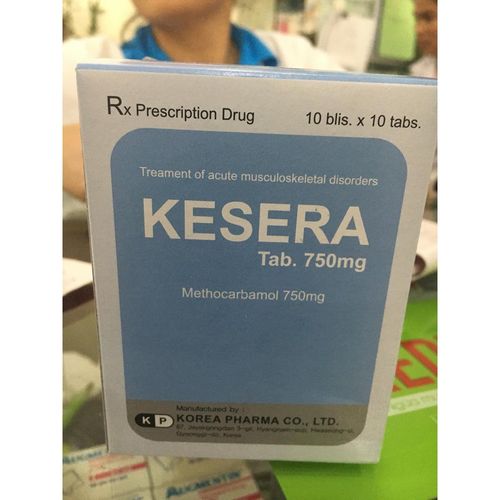This is an automatically translated article.
Colthimus 4mg drug is one of the drugs used to treat spasticity caused by nerve disorders, muscle spasms causing pain - low back pain, torticollis, ... The following article will provide more information refer to the use of Colthimus, how to use, and when to use Colthimus.
1. What is Colthimus 4mg?
Colthimus medicine has the main ingredient is Tizanidin (as Tizanidin hydrochloride) 4 mg. Colthimus drug of Ha Tay Pharmaceutical Joint Stock Company. Colthimus is used to treat muscle spasticity caused by multiple sclerosis or spinal cord injury, as well as pain caused by muscle spasms.
Colthimus medicine is made in the form of cylindrical tablets, 8mm in diameter, with a (+) line in the middle, white or ivory white, with healthy walls and edges.
Packing in the form of a box of 10 blisters x 10 tablets, with instructions on how to use the medicine inside the box.
2. What are the uses of Colthimus 4mg?
Used in the treatment of painful muscle spasms:
In disorders of balance and function in the spinal region (neck or lumbar syndromes, such as scoliosis or backache); After surgery, such as surgery for a herniated disc in the lumbar spine or osteoarthritis in the hip. Nervous spasticity: multiple sclerosis, chronic vascular disease of the spinal cord, degenerative spondylolisthesis, cerebrovascular accident and cerebral palsy.
3. How to use Colthimus 4mg effectively?
3.1. How to use Colthimus drug taken orally, has a relatively short effect (maximum effect within 2-3 hours after taking the drug) so it must be taken several times a day (3-4 times a day). The duration and frequency of dosing depends on the needs of the patient. The dose should be adjusted according to the patient's response.
Optimal therapeutic response is usually achieved with a daily dose of 12 mg to 24 mg administered in 3 or 4 equal doses, the single dose should not exceed 12 mg. The total daily dose should not exceed 36 mg.
In case of discontinuation of treatment in patients receiving high doses for a long time, the dose should be gradually reduced.
3.2 . Dosage of Colthimus Adults and people 18 years of age and older
Treatment of spasticity
Usual starting dose: 2 mg/single dose. Then, depending on the individual patient's response, the dose may be gradually increased by 2 mg, spaced at least 3 to 4 days apart, usually up to 24 mg/day in 3-4 divided doses. The maximum recommended dose is 36 mg/day. Treatment of pain caused by muscle contraction
Oral dose of 4mg/time, taken 1-3 times/day. For patients with renal failure with creatinine clearance < 25 ml/min. Initial dose is 2 mg/time, 1 time/day. Then gradually increase until the desired effect is achieved. Each increase should not exceed 2 mg. The dose should be increased slowly once a day before increasing the number of times a day. Renal function must be monitored. Elderly
Usual dose as young people. Dosage adjustment may be required because renal clearance may be reduced by 4 times compared with normal adults.
Children under 18 years old
Differences between children and adults such as pharmacokinetics, pharmacodynamics, side effects... especially children are not allowed to enter clinical trials before licensing of new drugs. Therefore, using this drug for children should be very careful even with drugs that have not been warned.
4. Contraindications of Colthimus
Hypersensitivity to drug components. Severe liver failure.
5. Adverse drug interactions of Colthimus 4mg
Colthimus may interact with other drugs?
Remember that drug interactions with other drugs are often quite complicated due to the influence of many ingredients in the drug. Studies or recommendations usually only state common interactions with use. Therefore, do not arbitrarily apply information about Colthimus drug interactions if you are not a researcher, doctor or medical person.
Colthimus drug interacts with food and drinks
Need to be careful when using together with alcohol, beer, tobacco, alcoholic or fermented drinks. Factors that can change the composition of the drug. See details in the leaflet or consult your doctor or pharmacist for more details.
6. Colthimus side effects
If used at the recommended dose for painful muscle spasms, side effects are rare and, if they occur, are mild and transient, including drowsiness, fatigue, dizziness, dry mouth, and hypotension. low blood pressure.
Rare: vomiting, gastrointestinal disturbances, transient increase in transaminases. At doses higher than those recommended for the treatment of atrial fibrillation, these side effects are more common and may be severe. However, it is rarely necessary to discontinue treatment. Occasionally there may be a drop in blood pressure and bradycardia.
Rare: muscle weakness, somnolence, sleep disturbance, hallucinations.
Very rare : acute hepatitis.
Other side effects of Colthimus
It should be noted that this is not a complete list of Colthimus side effects. During use may occur other side effects that have not been shown or have not been studied. If there are any other side effects of Colthimus that are not specified in the instructions for use, consult your doctor or pharmacist.
7. Note before taking Colthimus
Because liver failure has been reported with tizanidine in doses of 12 mg, it is recommended to monitor liver function during the first 4 months in patients receiving doses ≥ 12 mg, and when patients have symptoms suggestive of impaired liver function such as sadness vomiting, loss of appetite, fatigue. Discontinue when SGOT and SGPT are 3 times higher than normal.
In patients with renal impairment (creatinine clearance < 25 ml/min), an initial dose of 2 mg/day is recommended. Increase dose gradually according to tolerability and effectiveness. If there is improvement, it should be used once a day before increasing to several times a day.
Patients who feel drowsy at the start of the drug should not do activities that require alertness such as driving a car or operating machinery. Experience with the use of tizanidine in children is limited. During pregnancy and lactation, Tizanidine was not teratogenic in animals. However, the safety of use for pregnant women has not been established. The current knowledge of drug excretion in human milk is limited.
Notes on taking Colthimus during pregnancy
General note during pregnancy: Drugs used during pregnancy can cause adverse effects (miscarriage, teratogenicity, fetal malformations... ) to any developmental stage of pregnancy, especially the first trimester. Therefore, it is best not to use the drug for pregnant women. In the case of mandatory use, it is necessary to consult carefully with your doctor, pharmacist before making a decision.
Precautions for taking Colthimus during lactation
General note during lactation: The drug can be passed to the baby through breastfeeding. It is best not to or limit the use of the drug during breastfeeding. Many drugs have not yet fully determined the effects of the drug during this period, so mothers need to carefully read the instructions for use and consult with doctors and pharmacists before deciding to use the drug.
Using drugs for drivers and operating machines
There are no specific reports on the effects of the drug on drivers and operating machines. However, to be on the safe side, you should consult your doctor before use.
8. How to store Colthimus?
Concentration, content, active ingredients of the drug are affected if the drug is not good or when the expiry date is expired, leading to harm when used. Carefully read the information on the storage and expiry date of the medicine listed on the product packaging and the package insert. Usually medicines are stored at room temperature, away from moisture and light. When medication is past its expiration date or cannot be used, consult your doctor, pharmacist or garbage disposal for a safe way to dispose of it. Keep Colthimus out of the reach of children and away from pets.
Please dial HOTLINE for more information or register for an appointment HERE. Download MyVinmec app to make appointments faster and to manage your bookings easily.













